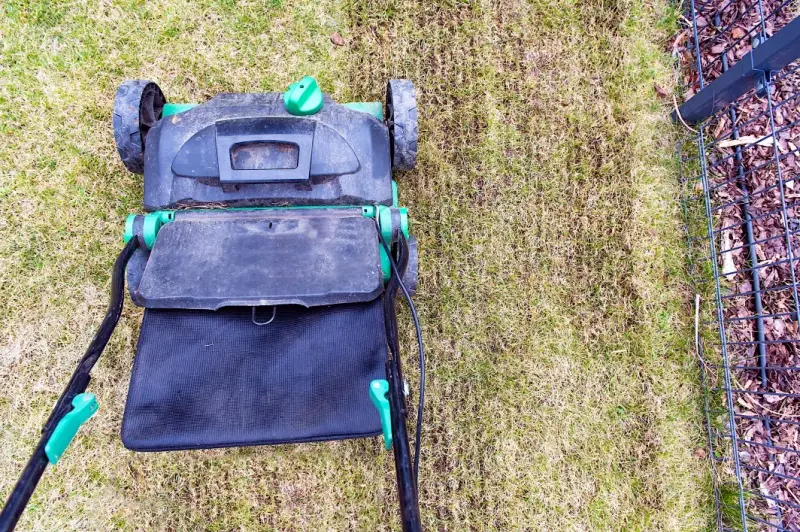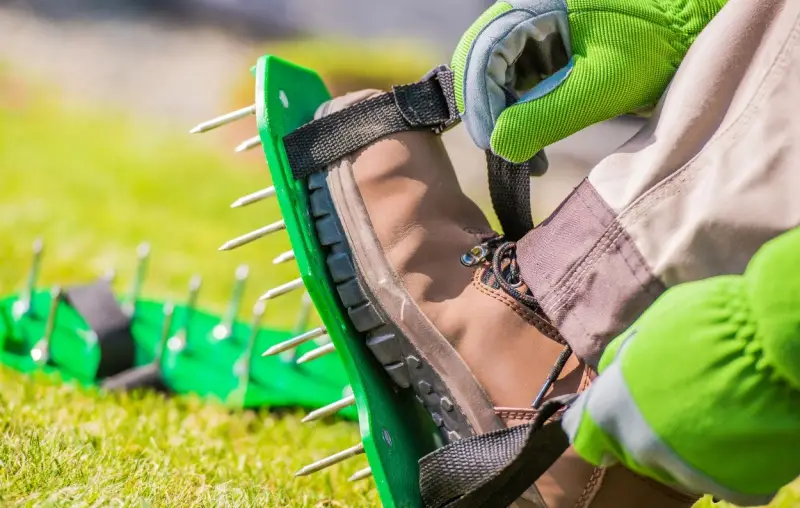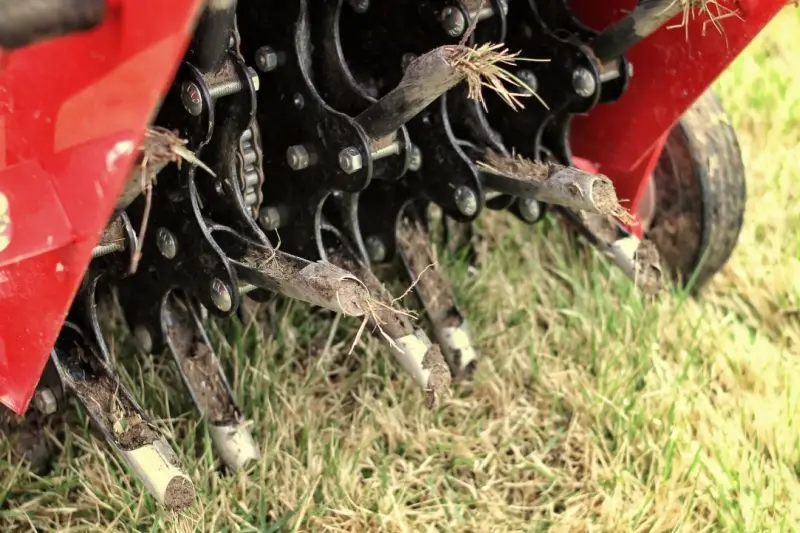
The Grounds Guys explain the differences between spike and plug aerators for lawn care.
|
Your lawn's soil can become compacted over time, making it difficult for your grass to thrive. That’s why most landscapers, including The Grounds Guys®, recommend that homeowners aerate their lawns at least once a year. (Some soil types will require more frequent aeration.) When it comes time to aerate, the two methods for getting the job done are spike aerators and plug aerators.
Aeration: Why It’s Critical for Your Lawn
Heavy foot traffic and plain old time can gradually compact your soil. Compacted solid makes it hard for the roots of your grass to receive oxygen, water, and nutrients. The solution? Aeration.
Lawn aeration creates small holes or openings in the soil to allow important elements like air, water, and nutrients to hit the grass roots more efficiently. Some of the most important benefits of aeration include:
- Reducing soil compaction
- Improving drainage
- Enhancing nutrient absorption
- Promoting thatch breakdown
Aeration is performed using a special device called an aerator. Numerous types of aerators are on the market, but they fall into two main categories: spike aerators and plug aerators (also called core aerators).
What are the differences between spike aerators vs. plug aerators? Let’s find out.
What Are Spike Aerators?

Spike aerators are any type of aerator that uses solid tines to make holes in the ground. Think of jabbing a fork into cookie dough, and you’ll get the picture. Unlike plug aerators, Spike aerators do not remove soil from your lawn and typically do not penetrate as deeply as plug aerators.
Spike aerators typically work best on smaller lawns with no rocky or clay soil.
When it comes to performing spike aeration, you have options. A pitchfork can do the job for extremely small lawns. For larger lawns, you can use spike shoes, a rolling push aerator, or a tow-behind spike aerator. You can usually pick up a pair of spike shoes at your local home improvement store for under $20.
Rolling push aerators can be physically challenging to operate, especially since it’s a good idea to go over your lawn twice. Many home improvement stores offer rolling push aerators for rent. If you want a tow-behind spike aerator, you’ll likely need to buy it. Prices start around $100 and go up from there.
What Are Plug Aerators?

When professional landscapers perform aeration, they almost always use plug or core aerators. These devices have hollow tins that pull soil plugs out of the ground and leave them on the lawn. While core aerators can make a lawn look a little messy in the short term, they do a great job of loosening soil and allowing nutrients and other essential elements to reach grass roots.
Choosing the right time of year to use a plug aerator on your lawn is important, as the process can stress your grass. The best time to aerate is during the active growing season. For cool-season grasses, that’s the fall. For warm-season grasses, aerate in the spring.
The three most common types of plug aerators are manual, gas-powered, and tow-behind. Manual aerators are the least expensive option but also the most physically challenging to use. They look like a modified pitchfork with hollow tines, which you press into the ground with your foot. Manual aerators work best for spot aeration, as you wouldn’t want to use them on a large lawn.
Entry-level tow-behind core aerators can be purchased for under $100, but you’ll need a lawn tractor to hook them up. Gas-powered core aerators will set you back at least $1,000, but you can also rent one at a reasonable rate at many home improvement stores.
Spike Aerator vs Plug Aerator: What’s Our Pick?
When it comes to aerator core vs. spike, there’s just no contest. We recommend you choose a core aerator. Why? Spike aerators can loosen soil in the short term, but since they don’t actually remove soil from the ground, they usually end up compacting soil even more in the long run. Core aeration, on the other hand, allows water, air, and nutrients to penetrate deeply into the soil, allowing your grass roots to grow deep and strong.
At The Grounds Guys, we don’t believe in cutting corners or taking the easy way out. We focus on doing what's best for your lawn's long-term health. That’s why we only perform core aeration for our customers.
Of course, core aeration can be more physically challenging for the average homeowner. If you would rather hand off your lawn aeration to the pros, contact us today.
We are committed to doing the job right. That’s part of the Neighborly Done Right Promise®. In addition to lawn aeration, we perform services such as fertilization, seasonal cleanups, weed control, and more. We also offer ongoing lawn maintenance to ensure your grass always looks its best.
Ready to give your lawn a facelift? Find your local The Grounds Guys today and request a free estimate.
FAQs About Aerators for Lawns
Our 200 franchise locations across the U.S. and Canada share a common goal — using our years of experience and expertise to help you bring the vision for their property to life. This includes answering questions you have about landscaping and lawn care. Below are answers to some of the most frequently asked questions about lawn aerators.
What is the difference between spike aerators and plug aerators?
The difference between lawn aerators lies in how they create openings in your soil. Spike aerators use solid tines to poke holes into the ground, similar to jabbing a fork into compacted earth. They don't remove any soil and typically don't penetrate deeply into the lawn.
Plug aerators (also called core aerators) use hollow tines that pull soil plugs out of the ground, leaving them scattered on the lawn's surface. While this creates a temporarily messy appearance, core aerators penetrate deeper and provide much more effective soil decompaction than spike aerators. In fact, while plug aeration creates lasting relief from soil compaction, spike aeration can actually worsen compaction over time by pushing soil particles tighter together around the holes.
Why is core (plug) aeration generally recommended over spike aeration?
Professional landscapers consistently choose core aerators because they deliver superior long-term results for your lawn's health.
While spike aerators can loosen soil temporarily, they often create more problems than they solve. In fact, spike aeration can actually worsen soil compaction! The solid tines can push soil particles together around the holes rather than removing compacted material, essentially creating small pockets of even more compressed soil.
Core aeration removes compacted soil entirely, creating genuine pathways for air, water, and nutrients to reach grass roots. The soil plugs left on your lawn's surface may look messy, but they’ll naturally break down and provide additional organic matter for your soil.
Additionally, core aerators penetrate deeper into the soil than most spike aerators, addressing compaction issues at the root level where your grass needs the most help. Deeper penetration promotes stronger root development and better overall lawn health.
Finally, professional landscaping providers tend to prefer core aerators for customer lawns because they deliver superior, lasting results.
What are some signs that indicate your lawn may need aeration?
Keep an eye out for the following common indicators that your lawn may benefit from aeration:
- Water pooling: Water pooling on the lawn after rain or irrigation is one of the most obvious signs that your lawn needs aeration. When water can't penetrate compacted soil, it has nowhere to go but sideways.
- Tough soil penetration: Difficulty pushing a screwdriver or garden tool into the soil signals that your lawn's root zone has become too dense. Healthy soil should allow easy penetration to a depth of 6–8 inches.
- Unhealthy grass: Look for thin or patchy grass growth, especially in high-traffic areas like walkways, play areas, or spots where vehicles frequently park. Compacted soil restricts root development, leading to weak, sparse grass that struggles to compete with weeds.
- Thatch buildup: Excessive thatch buildup (a layer of dead grass and organic matter more than half an inch thick) often indicates compacted soil. Proper decomposition requires adequate air circulation in the soil, which is impossible if it’s too compacted.
- High usage: Frequent foot traffic automatically puts your lawn at higher risk for compaction. If your property experiences regular use from pets, children, or outdoor entertaining, annual aeration becomes even more important for maintaining healthy grass.
- Clay soil: Heavy clay soil is easily compacted and can benefit from more frequent aeration than looser soils.
- Seasonal grasses: Cool-season grasses benefit most from fall aeration during their active growing period, while warm-season grasses should be aerated in spring when they're actively growing and can recover quickly from the process.
This article is intended for general informational purposes only and may not be applicable to every situation. You are responsible for determining the proper course of action for your home and property. The Grounds Guys are not responsible for any damages that occur as a result of this blog content or your actions. For the most accurate guidance, contact The Grounds Guys location nearest you for a comprehensive, on-site assessment.